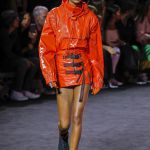
The PVC revolution in the fashion world
From Prada to Gucci, all the brands are taking back the material "invented by chance"
November 29th, 2018
No. I would never wear sandals with socks. Never ever would I resurrect fanny pack or cyclists from the closet of memories. Not even in a thousand years you will see me with garments that are too tight or oversized. We swore. Then some group of "enlightened" designers joined forces to convince us that, no, those outfits were not the incarnation of absolute evil, but rather the maximum of the coolness to which we, poor mortals, could aspire. And what did we do? Did we rebel against the umpteenth diktat? Not a chance. One, after another, we have worn each of those proposals, regardless of the common sense that had guided us until then. Which ex faux pas became the lastest trend? Answer: PVC. Take a look at these fashion shows, editorials and streetstyle shots and you'll see an invasion of pieces made of this material, clear, colored or in its vinyl version. A fever that invades everyone as it hadn't happened since the time of Paco Rabanne in the late '60s.

Space Age vs Mods
It's 1872 when German scientist Eugen Bauman by accidentally leaveing vinyl chloride exposed to sunlight discovers PVC, patented only in 1913 by his compatriot Frederich Heinrich August Klatte. If the invention of the new material is all made in Europe, its significant entry into the market takes place in the United States with the crisis of the 1920s. Here, the company BFGoodrich, looking for a viable alternative to the too expensive natural rubber to be used as a waterproof coating for fabrics, hires Waldo Semon which plasticizes PVC and thus creates vinyl. The commercial success of polyvinylchloride is immediate and, little by little, its use expands like wildfire, infiltrating every sector. Including fashion. In this world, the first to experiment with synthetic substances is Elsa Schiaparelli (remember the necklace of insects in rhodofano, a sort cellophane’s cousin?). But it is later, in the Sixties, that PVC establishes itself as the material of the time. In 1966, inspired by the work of the Italian designer, a young architecture student named Paco Rabanne, presents the 12 Unwearable Dresses in contemporary materials collection and brings clothes made of plastic and metal on the catwalk, changing the history of fashion forever. From Peggy Guggenheim to Brigitte Bardot, everyone goes crazy for his creations, but also for those of André Courrèges and Pierre Cardin.
In their hands, the discovery of Bauman becomes the way to transform ready to wear into something out of the ordinary, futuristic, into the ideal element to shape the Space Age. The futuristic aspect of this material is not the only one to be explored. With the anti-slip plastic garments by Betsy Johnson, the "wet look" dresses and the Quant Afoot shoe line by Mary Quant, its playful, fun, pop side emerges and the PVC pieces play a fundamental role in every Mods outfit.
It’s all cinema & Prada’s fault
Its definitive consecration comes from the cinema: from Paco Rabanne’s black suit worn by Audrey Hepburn in Two For The Road to Carrie-Anne Moss in the Matrix trilogy, from Catherine Deneuve's trench in Belle de jour to Mira Sorvino and Lisa Kudrow in Romy and Michele's High School Reunion, until Kate Beckinsale in the Underworld saga or Charlize Theron in Atomic Blonde. All these movies (and many others, often sci-fi or super heroes films) give the polyvinylchloride a virtual continuity of use which, in reality, has a much more fluctuating trend. In the decades following Sixties and Seventies, in fact, plastic materials are increasingly associated with the idea of cheapness, trash or extravagance. To turn their destiny upside down, paving the way back, in the 90s is Prada teaching how to treat them as if they were precious fabrics and, with its nylon backpack, creates a must-have item that has now returned to stores with the same success. One at a time, the designers return to fall in love with it, especially with transparent PVC and its vinyl version.
Here we are
In the new millennium, accessories and clothes of that type are multiplied in all the proposals of major brands: Dior, Jean Paul Gaultier, Maison Margiela, Loewe, Valentino, Louis Vuitton, Vetements, Calvin Klein,... After that this year Chanel has covered in polyvinyl chloride the classic suits, bags, tourist hats, raincoats and cuissard, 2018 has officially become the year of PVC. Fashionistas from all over the world, influencers and celebrities, led by Kim Kardashian, show off Off-White x Jimmy Choo and Yeezy decolletés, Burberry's clear trench (favorite item for PVC) and shopper result of the collaboration between Comme des Garçons and Gucci. So, for the umpteenth time, an element considered totally out of fashion, is the object of the definitive desire.

















































































































































